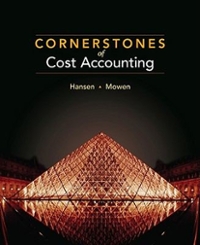Answered step by step
Verified Expert Solution
Question
1 Approved Answer
On January 1, 2008, Nobel Corporation acquired machinery at a cost of $600,000. Nobel adopted the straight-line method of depreciation for this machine and had
On January 1, 2008, Nobel Corporation acquired machinery at a cost of $600,000. Nobel adopted the straight-line method of depreciation for this machine and had been recording depreciation over an estimated life of ten years, with no residual value. At the beginning of 2011, a decision was made to change to the double-declining balance method of depreciation for this machine. Assuming a 30% tax rate, the cumulative effect of this accounting change on beginning retained earnings, is $67,200. $0. $78,960. $112,800. Question 2 10 points Save Companies record corrections of errors from prior periods as an adjustment to the beginning balance of retained earnings in the current period. True False Question 3 10 points Save On January 1, 2008, Neal Corporation acquired equipment at a cost of $540,000. Neal adopted the sum-of-the-years-digits method of depreciation for this equipment and had been recording depreciation over an estimated life of eight years, with no residual value. At the beginning of 2011, a decision was made to change to the straight-line method of depreciation for this equipment. The depreciation expense for 2011 would be $28,125. $45,000. $67,500. $108,000. Question 4 10 points Save One of the disclosure requirements for a change in accounting principle is to show the cumulative effect of the change on retained earnings as of the beginning of the earliest period presented. True False Question 5 10 points Save The estimated life of a building that has been depreciated 30 years of an originally estimated life of 50 years has been revised to a remaining life of 10 years. Based on this information, the accountant should continue to depreciate the building over the original 50-year life. depreciate the remaining book value over the remaining life of the asset. adjust accumulated depreciation to its appropriate balance, through net income, based on a 40-year life, and then depreciate the adjusted book value as though the estimated life had always been 40 years. adjust accumulated depreciation to its appropriate balance through retained earnings, based on a 40-year life, and then depreciate the adjusted book value as though the estimated life had always been 40 years. Question 6 10 points Save A company changes from straight-line to an accelerated method of calculating depreciation, which will be similar to the method used for tax purposes. The entry to record this change should include a credit to Accumulated Depreciation. debit to Retained Earnings in the amount of the difference on prior years. debit to Deferred Tax Asset. credit to Deferred Tax Liability. Question 7 10 points Save An example of a correction of an error in previously issued financial statements is a change from the FIFO method of inventory valuation to the LIFO method. in the service life of plant assets, based on changes in the economic environment. from the cash basis of accounting to the accrual basis of accounting. in the tax assessment related to a prior period. Question 8 10 points Save Link Co. purchased machinery that cost $810,000 on January 4, 2009. The entire cost was recorded as an expense. The machinery has a nine-year life and a $54,000 residual value. The error was discovered on December 20, 2011. Ignore income tax considerations. Link's income statement for the year ended December 31, 2011, should show the cumulative effect of this error in the amount of $726,000. $642,000. $558,000. $0. Question 9 10 points Save On January 1, 2010, Janik Corp. acquired a machine at a cost of $500,000. It is to be depreciated on the straight-line method over a five-year period with no residual value. Because of a bookkeeping error, no depreciation was recognized in Janik's 2010 financial statements. The oversight was discovered during the preparation of Janik's 2011 financial statements. Depreciation expense on this machine for 2011 should be $0. $100,000. $125,000. $200,000. Question 10 10 points Save Lanier Company began operations on January 1, 2010, and uses the FIFO method in costing its raw material inventory. Management is contemplating a change to the LIFO method and is interested in determining what effect such a change will have on net income. Accordingly, the following information has been developed: Based upon the above information, a change to the LIFO method in 2011 would result in net income for 2011 of $540,000. $600,000. $620,000. $660,000. Question 11 10 points Save Black, Inc. is a calendar-year corporation whose financial statements for 2010 and 2011 included errors as follows: Assume that purchases were recorded correctly and that no correcting entries were made at December 31, 2010, or at December 31, 2011. Ignoring income taxes, by how much should Black's retained earnings be retroactively adjusted at January 1, 2012? $144,000 increase $36,000 increase $18,000 decrease $9,000 increase Question 12 10 points Save Counterbalancing errors do not include errors that correct themselves in two years. errors that correct themselves in three years. an understatement of purchases. an overstatement of unearned revenue
Step by Step Solution
There are 3 Steps involved in it
Step: 1

Get Instant Access to Expert-Tailored Solutions
See step-by-step solutions with expert insights and AI powered tools for academic success
Step: 2

Step: 3

Ace Your Homework with AI
Get the answers you need in no time with our AI-driven, step-by-step assistance
Get Started


